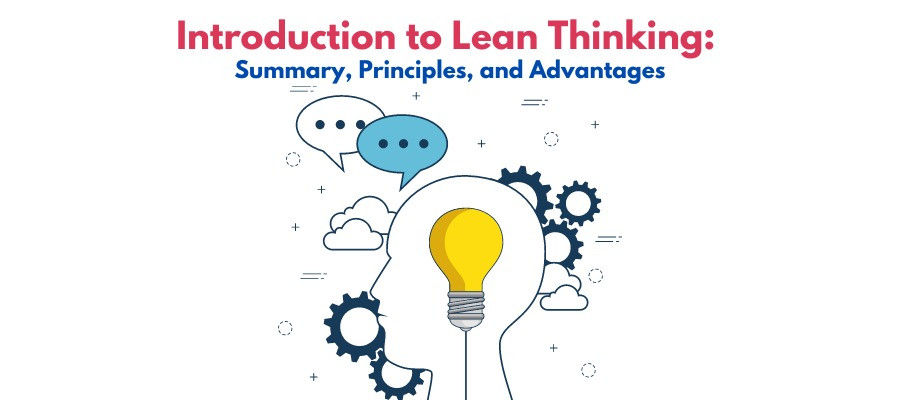Introduction to Lean Thinking Summary, Principles, and Advantages

In today's rapidly changing market, where customers hold extraordinary power, organizations must find effective ways to meet their needs. Lean Thinking provides a powerful approach to executing business initiatives that align with customer demand.
In this article, we will delve into the concept of Lean Thinking, its historical origins, core principles, and its myriad benefits. By understanding Lean Thinking, businesses can enhance efficiency, streamline processes, and create more customer value.
What is Lean Thinking?
Lean thinking originated in the Japanese auto industry after World War II, with companies like Toyota leading the way in implementing lean manufacturing techniques. The primary objective of Lean Thinking is to remove waste and inefficiencies from processes while focusing on delivering value to customers.
Organizations can enhance productivity, quality, and cost-effectiveness by eliminating various forms of waste, such as overproduction, waiting, transportation, inventory, motion, defects, and underutilized resources.
The History of Lean Thinking
The roots of Lean Thinking can be traced back to Toyota's efforts in the 1950s to improve manufacturing efficiency and quality. The fundamental idea behind Lean Thinking is waste reduction, encompassing areas such as overproduction, waiting, transportation, inventory, motion, defects, and underutilized resources.
Over time, Lean Thinking has transcended manufacturing and found applications in diverse industries such as healthcare, construction, and software development. In recent years, there has been a resurgence of interest in Lean Thinking as organizations seek to become more agile and responsive to change.
The Four Principles of Lean Thinking
Lean Thinking is guided by four fundamental principles that can be applied at all levels of an organization, from individual projects to overall strategy:
Defining value from the customer's perspective: This principle emphasizes the importance of effectively understanding and meeting customer needs and expectations.
Identifying and eliminating waste: Lean Thinking seeks to uncover and eliminate any activities or processes that do not add value to the customer or the organization.
Creating flow: The principle of creating flow involves establishing smooth and uninterrupted processes that ensure the timely delivery of products or services to customers.
Pursuing perfection: Lean Thinking emphasizes continuous improvement, aiming to achieve perfection in processes, products, and services through ongoing refinement and innovation.
Benefits of Lean Thinking
Implementing Lean Thinking practices can yield numerous benefits for organizations, including:
Improved quality: Lean Thinking methodologies focus on identifying and resolving issues contributing to defects, resulting in higher-quality products and services.
Reduced lead times: By eliminating waste and streamlining processes, Lean Thinking enables organizations to deliver products and services more quickly and efficiently.
Increased transparency and communication: Lean Thinking fosters open communication and transparency within an organization, facilitating collaboration and problem-solving.
Lower costs: Waste reduction and process optimization lead to cost savings, making organizations more financially efficient and competitive.
Higher employee engagement: Lean Thinking encourages employee involvement and empowerment, fostering a culture of continuous improvement and increasing employee satisfaction and engagement.
Applications of Lean Thinking in the Modern World
The principles of Lean Thinking can be applied across a wide range of industries and organizations. It extends beyond traditional manufacturing and has succeeded in healthcare, education, construction, and service-oriented sectors. Lean Thinking can be particularly beneficial in areas such as:
Just-in-time principles: By implementing just-in-time principles, organizations can minimize inventory levels, reduce waste, and enhance customer satisfaction.
Continuous improvement: Lean Thinking supports implementing continuous improvement programs, allowing organizations to make incremental enhancements over time and adapt to changing market dynamics effectively.
Streamlining healthcare processes: Lean Thinking has found significant success in healthcare by improving patient flow, reducing wait times, eliminating bottlenecks, and enhancing overall efficiency. It helps healthcare organizations deliver higher-quality care with fewer resources, leading to better patient outcomes and improved patient satisfaction.
Lean in education: Lean principles can be applied in educational institutions to optimize administrative processes, reduce paperwork, eliminate non-value-added activities, and improve student services. Lean education aims to create a lean culture focusing on continuous improvement, student-centered approaches, and efficient resource allocation.
Pillars of Lean Thinking
Lean Thinking rests upon two fundamental pillars: Continuous Improvement and Respect for People. These pillars form the basis for making sound business decisions and developing strategies that create more productive systems within an organization.
Continuous Improvement: Organizations committed to Lean Thinking embrace a culture of continuous improvement. Teams are empowered to identify and eliminate non-value-added activities, focusing on high-priority tasks that contribute to organizational goals.
Respect for People: Respect is a core value within Lean Thinking. Employees spend time understanding the needs of their customers and colleagues, enabling them to work collaboratively and meet those needs effectively. When respect is deeply embedded in an organization's DNA, it permeates all aspects of its operations.
Conclusion
Lean Thinking offers organizations a robust framework for enhancing efficiency, reducing waste, and delivering excellent customer value. By embracing the principles of Lean Thinking, businesses can embark on a journey of continuous improvement and foster a culture of respect and collaboration.
Lean Thinking is not limited to any specific industry; its applications span diverse sectors, allowing organizations to streamline their processes, reduce costs, and ultimately meet the ever-evolving demands of their customers.
Reference
- https://www.tutorialspoint.com/lean-thinking-overview-origins-principles-benefits-and-applications#:~:text=Lean%20thinking%20is%20a%20management,industry%20after%20World%20War%20II.



